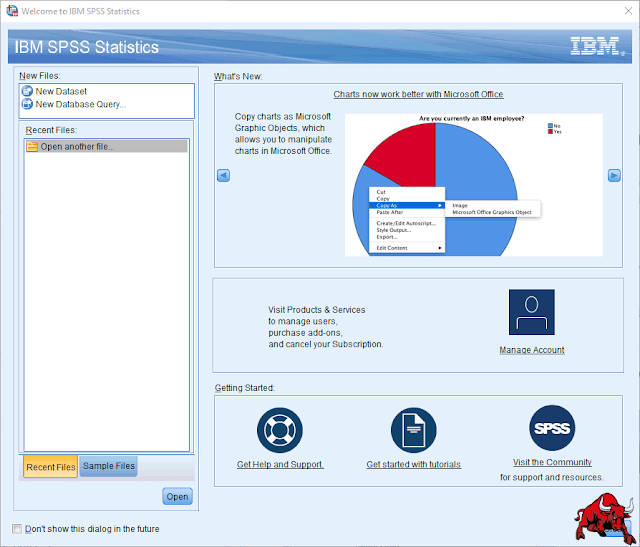What it can do for your business
Find the SPSS icon with the most current version number. As of August 2018, the latest version is version 25. Click the icon, and select intall. The install should occur in the background. IBM® SPSS® Custom Tables enables you to summarize SPSS Statistics data, and display your analyses as presentation-quality, production-ready tables. It provides analytical capabilities to help you learn from your data, and offers advanced features that allow you to build tables. But if you’re putting the table in a report that will be sent to others, you need the SPSS Custom Tables module. By the way, with practice, it takes only a few seconds to make the custom version, and you can use Syntax to further customize the table! Starting in version 27, the Custom Tables module is part of the standard edition. Create a custom 'Table Look Style', by 'Editing' the initial table's 'Look Style' and saving the changes as a custom 'style' ('APA Table' seems like a reasonable choice). Adjust your SPSS settings (options) so that SPSS recognizes your newly created 'Look Style' as the default table 'Look Style'.
IBM® SPSS® Advanced Statistics provides a sophisticated set of univariate and multivariate analytical techniques and models. It includes generalized linear mixed models (GLMM), general linear models (GLM), mixed models procedures, generalized linear models (GENLIN) and generalized estimating equations (GEE) procedures. Gain deeper insights from data to help solve real-world problems in disciplines such as manufacturing, pharmaceuticals and market research.
This module is included in the SPSS Premium edition for on-premises and in the Custom Tables and Advanced Statistics add-on for subscription plans.
General linear models (GLM)
Describe the relationship between a dependent variable and a set of independent variables. Use flexible design and contrast options to estimate means and variances and test and predict means. Mix and match categorical and continuous predictors to build models. Use linear mixed models for greater accuracy when predicting nonlinear outcomes. Formulate dozens of models, including split-plot design, multilevel models with fixed-effects covariance, and randomized complete blocks design.
Generalized linear models (GENLIN)

Provide a unifying framework that includes classical linear models with normally distributed dependent variables, logistic and probit models for binary data, and loglinear models for count data — as well as various other nonstandard regression-type models. Apply many general statistical models, including ordinal regression, Tweedie regression, Poisson regression, Gamma regression and negative binomial regression.
Linear mixed models/hierarchical linear models (HLM)
Model means, variances and covariances in data that display correlation and non-constant variability. Formulate dozens of models, including split-plot design, multilevel models with fixed-effects covariance, and randomized complete blocks design. Select from 11 non-spatial covariance types. Improve accuracy with repeated measures data, including situations in which there are different numbers of repeated measurements, different intervals for different cases or both.
Generalized estimating equations (GEE) procedures
Extend generalized linear models to accommodate correlated longitudinal data and clustered data. Model correlations within subjects.
Generalized linear mixed models (GLMM)
Access, manage and analyze virtually any kind of data set including survey data, corporate databases or data downloaded from the web. Run the GLMM procedure with ordinal values to build more accurate models when predicting nonlinear outcomes, such as whether a customer’s satisfaction level will fall under the low, medium or high category.
See all module features in license versions
Click the following link for a PDF with all modules and features in the license versions.
How To Install Spss Custom Tables Table
Multiple SPSS Statistics packages
Choose from two deployment options: a traditional license or subscription version. This module is part of the SPSS Statistics traditional license packages. To compare SPSS Statistics packages and learn where this module fits in, click the following product page link. Modules are only compatible with traditional license versions. The subscription version wraps the same features inside three optional subscription add-ons.
Survival analysis procedures
Spss Custom Tables
Choose from a flexible and comprehensive set of techniques for understanding terminal events such as part failure, death or survival rates. Use Kaplan-Meier estimations to gauge the length of time to an event. Select Cox regression to perform proportional hazard regression with time-to-response or duration response as the dependent variable.
Product images
Generalized Linear Mixed Models - Save Variable Options
Technical details
Software requirements
- For on-premises: Purchase the Premium edition.
- For subscription plans: Purchase the Custom Tables and Advanced Statistics add-on.
Hardware requirements
- Processor: 2 GHz or faster
- Display: 1024*768 or higher
- Memory: 4 GB of RAM required, 8 GB of RAM or more recommended
- Disk Space: 2 GB or more

Schedule time to discuss how SPSS Advanced Statistics can support your business needs.
Schedule time to discuss how SPSS Advanced Statistics can support your business needs.Book a consultation
Expert resources to help you succeed
Next Steps
Buy now to get started today
IBM SPSS Custom Tables is an analytical tool that helps you augment your reports with information your readers need to make more informed decisions.
Use inferential statistics—also known as significance testing—in your tables to perform common analyses: Compare means or proportions for demographic groups, customer segments, time periods, or other categorical variables; and identify trends, changes, or major differences in your data. IBM SPSS Custom Tables includes the following significance tests:
- Chi-square test of independence
- Comparison of column means (t test)
- Comparison of column proportions (z test)
Create A Table In Spss
You can also choose from a variety of summary statistics, which include everything from simple counts for categorical variables to measures of dispersion. Summary statistics are included for:
- Categorical variables
- Multiple response sets
- Scale variables
- Custom total summaries for categorical variables
How To Install Spss Custom Tables For Beginners
When your analysis is complete, you can use IBM SPSS Custom Tables to create customized tabular reports suitable for a variety of audiences—including those without a technical background.
